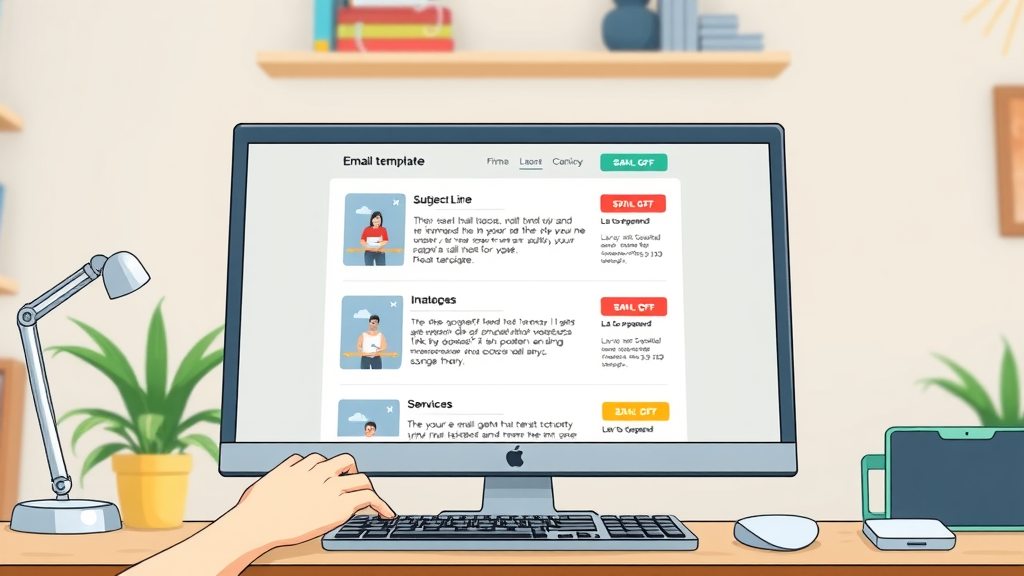Did you know that email marketing campaigns boast an average ROI of 4,200%? In a world flooded with marketing noise, mastering email marketing campaigns can unlock transformative business growth. This guide delivers step-by-step strategies to ensure your email marketing campaigns outperform the competition—every time.
-
What you'll discover:
How to build high-converting email marketing campaigns from scratch
Best practices for crafting irresistible subject lines and email copy
Techniques for segmenting your email list for maximum impact
Automation secrets for timely, personalized marketing campaigns
Case studies and examples from top-performing email marketing campaigns
Essential Foundations of High-Performing Email Marketing Campaigns
Explore the key principles behind top-performing email marketing campaigns and understand why strategic planning is critical for a successful marketing campaign. Includes an overview of various types of email marketing campaigns, from promotional emails to automated abandoned cart sequences.
In today’s digital marketplace, the most effective email marketing campaigns are built on a foundation of strategy, relevance, and consistency. Strategic planning remains the backbone of a successful email campaign—without it, your marketing efforts can easily blend into the background noise that clutters most inboxes. Whether your goal is to increase sales, drive brand awareness, nurture leads, or cement customer loyalty, every email campaign begins with a crystal-clear objective.
There are several essential types of email marketing campaigns, each designed with a unique purpose in mind. Promotional emails fuel product launches, seasonal sales, or exclusive offers. Transactional emails keep customers informed after purchases or sign-ups, while abandoned cart campaigns rescue lost sales opportunities. Automated series—such as welcome sequences or loyalty messages—maintain ongoing engagement and foster customer relationships beyond the first interaction. Studying successful marketing campaigns reveals that top performers always align their campaign types and goals for maximum impact.
What sets high-performing email campaigns apart is not only their content but also the way they are built. From personalized messaging to segmentation and strategic scheduling, every component should be optimized for the audience’s preferences and the campaign’s objectives. Remember, a well-structured email marketing campaign doesn’t just make noise—it drives measurable results and builds lasting customer connections.

Understanding the Psychology Behind Effective Email Campaigns
Unpack the science behind high-converting email marketing campaigns. Reveal how behavioral triggers, timing, and personalized email copy influence open rates and engagement, referencing the Rule of 7 in email marketing and relevant marketing strategies.
Behind every successful email marketing campaign is a deep understanding of audience psychology. Consumers encounter hundreds of marketing messages daily; only those emails that tap into behavioral triggers cut through the clutter. For example, the Rule of 7 suggests that potential customers must interact with your message at least seven times before taking action—highlighting the importance of consistency and multi-touch email campaigns. Timing matters, too: emails sent at the right moment (like abandoned cart reminders triggered within an hour of cart abandonment) can skyrocket open rates and conversions.
Personalized email copy is another cornerstone of engagement. Marketing strategies that incorporate the recipient's first name, prior browsing or purchasing behavior, and relevant content consistently outperform generic mass emails. When people feel understood, valued, and individually addressed, they’re much more likely to open, read, and click through your marketing email. Testing different behavioral triggers—such as scarcity (“Only 2 days left!”) or exclusivity (“Just for you”)—can help pinpoint what motivates your audience, making your email campaigns more persuasive and memorable.
By leveraging these psychological insights in every email campaign, marketers can intelligently nurture leads over time. This methodical approach turns fleeting attention into sustained interest—and, ultimately, higher conversions.
"Email marketing remains the most reliable channel for direct communication with your audience—when done correctly." – Industry Expert

Building and Segmenting Your Email List for Prolific Email Marketing Campaigns
Learn advanced tactics for ethically and efficiently growing your email list. Explore segmentation strategies to ensure every email campaign delivers targeted, tailored messages to specific audience groups.
A thriving email list is the heartbeat of every prosperous email marketing campaign. Growing your list ethically starts with enticing offers—think lead magnets, exclusive incentives, or early-access programs. Always prioritize permission-based signups to safeguard deliverability and maintain customer trust. But building a robust list is only half the battle; segmentation is where real magic happens. By dividing your subscribers into strategic segments—based on demographics, behavior, engagement, or purchase history—you turn each email campaign into a personal, relevant experience that resonates with recipients.
The best-performing email campaigns use layered segmentation to ensure the right content hits the right inboxes at the perfect time. For instance, targeting recent buyers with cross-sell product suggestions, or re-engaging dormant subscribers with special offers, leads to more conversions. Segmentation also helps refine your email copy and subject lines for each cohort, boosting both open rates and engagement. As your email list grows, regularly cleanse it by removing inactive users to improve email deliverability and maintain high engagement metrics. Remember, quality always trumps quantity—a focused, segmented list will outperform a generic, oversized one every time.
By combining advanced list-building tactics with granular segmentation strategies, your email marketing campaigns are primed to nurture leads, drive sales, and solidify lasting customer relationships.
Email List Segmentation Strategies | |
Segmentation Type |
Description |
|---|---|
Demographic Segmentation |
Divide by age, gender, location, or job title for tailored messaging. |
Behavioral Segmentation |
Target based on past actions—purchases, website visits, or clicked links. |
Engagement Level Segmentation |
Separate highly engaged subscribers from unengaged for personalized follow-ups. |
Purchase History Segmentation |
Suggest products or services based on what each subscriber has bought before. |
The Anatomy of Successful Email Templates and Email Copy
Analyze the must-have components for modern email templates—from engaging subject lines to effective CTAs. Discover the art and science of crafting compelling email copy for various types of email marketing campaigns, supported by real-world examples.
Modern email templates are a blend of art and science. Every high-performing email marketing campaign begins with a clean structure featuring an irresistible subject line , personalized preview text, a captivating opening, valuable content, and a clear call-to-action (CTA). The best templates prioritize mobile responsiveness, visual hierarchy, and brand consistency, ensuring your message is memorable across all devices.
Crafting impactful email copy means speaking to your subscribers’ pain points, aspirations, and interests in a relatable voice. Real-world examples show that short, benefit-driven sentences and visually distinct CTAs (buttons, not just links) drive more clicks and conversions. Personalization makes your marketing emails stand out—customizing offers based on previous buying behavior or browsing activity leads to higher open and conversion rates. Furthermore, color, typography, and images within the template must guide readers' eyes naturally toward desired actions, from clicking a discount code CTA to sharing content on social media .
Don’t overlook the importance of testing and iteration; even established email templates can be refined for stronger results. Analyze your best-performing campaigns, and use these insights to inform your template’s structure, content, and CTAs—keeping every marketing campaign fresh and effective.

Subject Line Secrets: Boosting Open Rates in Your Email Marketing Campaign
Delve into frameworks and formulas for writing subject lines that drive action. Learn from high-performing marketing campaigns and A/B testing results.
Your subject line is the gatekeeper of your email campaign—it's what compels recipients to click or ignore. Research reveals that emails with curiosity-driven or personalized subject lines achieve markedly higher open rates . Effective subject lines are concise, urgent, and relevant. Leverage numbers ("7 Ways to Improve Your Results"), questions ("Ready to Save 20% Today?"), or power words ("Limited Time", "Exclusive"). For the best email marketing campaigns, A/B testing is crucial: test two or more subject line variations with small audience segments and choose the one that yields the highest open rate for larger distribution.
Case studies show that integrating the recipient’s name or tapping into recent behavior (like “Forgot something? Your cart awaits”) can powerfully increase engagement. But beware of misleading or clickbait tactics—they may deliver an initial boost but harm long-term trust and deliverability. Consistent evaluation of subject line performance, informed by analytics and feedback, ensures each email campaign is honed for maximum impact.
Finally, consider preheader text as the supporting actor: it should complement the subject line and reinforce the value proposition, giving recipients an extra incentive to open your marketing email.
Structuring Email Templates for Engagement and Conversions
Examine top email templates and design best practices for increased engagement in every marketing campaign. Connect visual hierarchy and mobile optimization to higher click-through rates.
The layout of your email template directly shapes the user’s journey from open to click. High-converting templates begin with a strong headline and brief, value-driven message that’s easy to skim. Use subheadings, bullet points, and whitespace to break up content and direct attention to your CTA. Including images—aligned with your brand—adds visual appeal and helps messages resonate.
Visual hierarchy is paramount; your CTA should stand out in color, size, and placement, inviting action without overwhelming the reader. Responsive design can’t be ignored—over 60% of emails are opened on mobile devices, so ensure your emails look flawless and are fully navigable on every screen size. Accessibility matters, too: use high-contrast colors and readable font sizes, and always add alt text to images.
With each update, reference performance data from previous marketing campaigns. Adjust template components (CTA color, image placement, content length) in conjunction with A/B testing to learn what drives higher engagement and conversions for your audience.
Types of Email Marketing Campaigns: Strategies for Every Goal
Compare and contrast essential types of email marketing campaigns—including welcome sequences, abandoned cart reminders, seasonal promotions, and loyalty/re-engagement email campaigns. Includes guidance on selecting the right approach based on goals.
Every business objective warrants a tailored type of email marketing campaign. Welcome email campaigns set the stage for a lasting relationship with new subscribers, making the first impression count. Promotional email campaigns drive immediate sales and traffic through time-sensitive offers and discounts. Abandoned cart campaigns recover potentially lost revenue by following up with shoppers who leave without completing their purchase. Transactional and re-engagement campaigns drive repeat business, encourage reviews, and revive dormant lists.
The most successful marketing email strategies involve experimentation across these different types, matching the campaign style to your end goal. For instance, transactional email templates should reinforce trust and satisfaction, while promotional emails should harness urgency and a clear value proposition. Measuring the performance of each campaign type, especially through conversion rates and open rates, uncovers where your brand’s best opportunities for growth lie.
When selecting the right campaign type, consider your customer’s journey and your marketing goals. A mix of campaigns, running in sync, will maximize your brand’s impact, nurture leads at different stages, and stimulate ongoing engagement with your email list.
Welcome Email Campaigns
Promotional Email Campaigns
Abandoned Cart Campaigns
Transactional Email Campaigns
Re-engagement Email Campaigns
Crafting Automated Email Campaigns: Unlock Efficiency and Consistency
Show how automated email campaigns make marketing strategy scalable, timely, and personalized. Dive into triggers, scheduling, and automation workflows vital for efficient email marketing campaigns.
Automated email marketing campaigns deliver personalized messages at scale without manual intervention, freeing you to focus on strategy and results. Triggers—such as sign-ups, cart abandonment, or specific web behaviors—initiate timely communications that feel one-to-one, not one-to-many. The best automation workflows move prospects through well-defined stages, nurturing leads, accelerating conversions, and maintaining ongoing engagement.
Scheduling is another key pillar of automation. Stagger your messaging based on time zones, behaviors, and lifecycle stages to maximize reach and relevance. For instance, a series of emails triggered after a product purchase can include an order confirmation, a how-to guide, and a follow-up request for a review. Integration with your CRM or e-commerce platform enables advanced personalization, ensuring each recipient receives the right message at the optimal time.
Implementing a robust automation strategy also requires regular review and refinement. Analyze open rates, click-throughs, and conversion rates to spotlight bottlenecks and opportunities. The brands that stand out are the ones that view automation not just as a timesaver, but as a tool for delivering exceptional, consistent customer experiences across all marketing campaigns.

Data-Driven Marketing Campaigns: Metrics That Matter for Email Marketing Campaigns
Reveal the KPIs that define excelled performance in email marketing campaigns—open rate, click-through rate, conversions, unsubscribe rates. Learn how to interpret data and iterate for better marketing campaign outcomes.
A truly transformative email marketing campaign always tracks and analyzes key performance indicators (KPIs). The most important metrics include open rate (the percentage of recipients who open your message), click-through rate (the percentage who click a link inside), conversion rate (the percentage completing a desired action), and unsubscribe rate . Together, these metrics offer a full-spectrum view of campaign effectiveness and user engagement.
Benchmarking your results against industry standards helps reveal whether your marketing campaign is on track or requires adjustment. Low open rates might indicate weak or irrelevant subject lines. If click-throughs lag behind opens, your email copy or CTA may need refinement. Analyzing data from A/B testing further illuminates what drives conversions. Blindly launching email campaigns without reviewing results can lead to missed opportunities while continuous data-driven optimization uncovers what really resonates.
Regularly reporting and acting on your email marketing metrics encourages a culture of improvement and accountability. Each round of analysis empowers marketers to fine-tune their strategy, content, and timing for consistently better results in future marketing campaigns.
Key Performance Indicators (KPIs) for Email Marketing Campaigns |
||
Metric |
Definition |
Benchmark Value |
|---|---|---|
Open Rate |
Recipients who open the email |
20-25% |
Click-Through Rate |
Recipients who click a link in the email |
2-5% |
Conversion Rate |
Recipients who complete a goal (purchase, sign-up, etc.) |
1-3% |
Unsubscribe Rate |
Recipients who opt out from the list |
<0.5% |
Best Practices for Designing Marketing Emails That Engage and Convert
Cover modern design principles for marketing emails: mobile optimization, accessibility, use of interactive elements, and brand consistency across all marketing campaigns.
Checklist: Dos and Don'ts for Designing Email Marketing Campaigns
To ensure your marketing emails truly engage and convert, design must meet functionality. Mobile optimization is non-negotiable, as most recipients check emails on their smartphones. Use a single-column layout, large buttons, and flowing text to enhance legibility. Accessibility strengthens your campaigns even further; employ high-contrast colors, logical HTML structure, alt text for images, and readable fonts for all—helping your messages connect with every subscriber.
Interactive elements—like hover effects, GIFs, or polls—add vibrancy and encourage deeper interaction. But visuals must never come at the expense of clarity. Brand consistency, from logos to tone and color scheme, builds trust across all marketing campaigns and keeps your business top-of-mind. Test for compatibility across email clients before launching any campaign; poorly rendered emails can destroy even the best messaging.
Before you send, always review against a comprehensive checklist: Are your subject line and email copy compelling? Is your template optimized for mobile and accessibility? Do all links and CTAs function? Following proven design best practices ensures every email marketing campaign is positioned to drive conversions.

A/B Testing and Optimization: Refining Your Email Campaigns
Walk through advanced A/B testing methodologies for email marketing campaigns—testing subject lines, content, send time, CTA buttons, and personalization tactics to optimize every element.
A/B testing is the marketer’s secret weapon for continuous improvement. Rather than guessing which subject line, email copy, or send time will carry your message further, advanced testing methodologies let you measure real audience responses and optimize for conversion. Start by identifying a single element to test—for example, CTA button color or headline phrasing—and send variant versions to random segments of your list. Assess open rates, click-throughs, and conversions to pinpoint the winner.
Successful A/B testing extends beyond subject lines. Experiment with personalization, like custom product recommendations based on past purchases, or different offers such as a percentage discount versus a free shipping code. Test optimal sending days and times based on subscriber engagement history. And don’t stop at one round—ongoing testing ensures that your email marketing campaigns never stagnate and always reflect real subscriber preferences.
The most sophisticated marketing campaigns document every test, result, and lesson learned—building a knowledge bank that compounds your marketing advantage. Tracking ongoing optimizations ensures each new campaign is more effective than the last.

Leveraging Social Media and Multichannel Synergy to Amplify Email Marketing Campaigns
Examine integration tactics—how syncing your email marketing campaigns and marketing emails with social media can elevate reach and engagement. Explore case studies and best-performing examples from leading marketing campaigns.
Combining social media with email marketing creates a synergy that turbocharges your engagement and reach. By cross-promoting email newsletter signups through social channels or embedding social share buttons in your newsletters, you’ll organically grow your email list and foster greater interaction. The smartest brands reuse high-performing email content as posts or stories, reinforcing messages and maximizing visibility across every marketing campaign.
Case studies show that social media contests facilitated through email not only generate excitement but also drive new subscriber acquisition and viral growth. Meanwhile, retargeting email subscribers with custom social ads boosts the impact of both channels and leads to more conversions. When integrating these efforts, be sure to keep messaging and brand voice consistent; seamless customer experiences pay dividends over time.
Synchronization between email and social is now an essential piece of the holistic marketing puzzle, making every marketing strategy more visible, inclusive, and ultimately—more profitable.

Essential Compliance and Deliverability Factors for Powerful Email Marketing Campaigns
Break down legal compliance (GDPR, CAN-SPAM) and technical deliverability best practices for successful email marketing campaigns. Learn to avoid spam filters and foster customer trust with transparent marketing emails.
Powerful email marketing campaigns prioritize both legal compliance and technical deliverability from the outset. Compliance frameworks—like GDPR in Europe and CAN-SPAM in the US—demand explicit consent for marketing communications and a simple way to unsubscribe. Always obtain clear opt-ins and provide transparent privacy policies to foster lifelong trust with your subscribers.
To avoid landing in spam folders and undermining your email deliverability , confirm your sending domain setup (SPF, DKIM, DMARC), regularly clean your email list, and avoid deceptive or spammy subject lines. Consistent branding, honest email copy, and providing value in every marketing email all contribute to inbox placement rather than banishment to the junk folder.
Deliverability and compliance are ongoing—stay updated with regulations, monitor sender reputation, and troubleshoot bounce or spam complaints immediately. The best email marketing campaigns build their foundational trust by respecting the rules and exceeding user expectations.
Case Studies: High-Impact Email Marketing Campaigns From Top Brands
Show real-world examples of email marketing campaigns and marketing campaigns that moved metrics, drove growth, or went viral—analyzing what made them work.
The most illuminating lessons in email marketing come from brands that turn creative ideas into measurable wins. For example, a leading online retailer increased their open rate and conversion rate by designing a visually engaging welcome sequence and segmenting their list based on browsing habits. Meanwhile, a travel company saw a revenue spike after A/B testing abandoned cart email copy and timing triggered within 90 minutes of abandoned search.
High-performing campaign case studies consistently reveal a pattern: customization, timely automation, and persistent optimization deliver the highest ROI. One direct-to-consumer brand went viral with a loyalty campaign crafted around genuine customer stories, resulting in a 39% increase in email-driven sales within two months. Analyzing before-and-after metrics from these real campaigns uncovers what resonates with audiences and why.
When planning your next campaign, take inspiration from these success stories. Implement the frameworks and best practices that drove real-world results—your next winning marketing campaign is one step away.
Analyzing the Impact: Before-and-After Results from Real Campaigns

Frequently Overlooked Pitfalls in Email Marketing Campaigns and How to Avoid Them
Point out the most common mistakes marketers make with email marketing campaigns, from poor list hygiene to inconsistent branding, and provide actionable solutions.
Even seasoned marketers make costly errors that stunt the success of email marketing campaigns. One frequent pitfall is neglecting list hygiene ; failing to remove bounced or inactive addresses leads to poor deliverability, spam complaints, and wasted resources. Another is inconsistent branding or messaging, which erodes recipient trust and reduces open and click-through rates. Sending generic, irrelevant content rather than segmented, tailored messages is a surefire way to see engagement plummet.
Other common mistakes include using deceptive or clickbait subject lines, overlooking A/B testing , or failing to optimize for mobile devices. These blunders not only reduce conversions but can also damage your sender reputation over time. Likewise, neglecting compliance with evolving privacy regulations can trigger legal penalties and subscriber mistrust.
Avoiding these pitfalls requires a disciplined approach: maintain a clean email list, prioritize consistent branding and personalized email copy, relentlessly A/B test your campaigns, and stay abreast of legal and technical requirements. Successful email marketing campaigns are built on continuous improvement, trustworthy practices, and putting your audience first.
"Your next big win in email marketing campaigns isn't far away—it's found in relentless testing, smart segmentation, and authentic storytelling."
Expert Tips and Advanced Strategies for Next-Level Email Marketing Campaigns
Share expert-level techniques to boost open rates, increase click-through, personalize at scale, and use automation in marketing campaigns.
Elevate your email marketing campaigns to the next level by deploying advanced tactics that the pros use. Use dynamic content blocks to tailor subject lines, offers, and product recommendations in real time, matching each recipient’s behavior or profile. Harness predictive analytics to send emails based on when subscribers are most likely to open, and layer on smart automation workflows for cross-sell and up-sell opportunities post-purchase.
Segment deeply—not just by demographics but by engagement, purchase patterns, and content preferences. Implement powerful win-back sequences that combine email channels with social media retargeting for maximum conversion. Test send frequency; some audiences prefer a weekly touch, while others respond best to bi-weekly or monthly campaigns.
Finally, build a responsive feedback loop: encourage reviews, survey responses, or product ratings within your emails, then use that data to further personalize future marketing campaigns. Mastering these advanced strategies means you’ll consistently outpace competitors and fuel ongoing growth.
Master Checklist for Unbeatable Email Marketing Campaigns
Define clear objectives and target audiences for your email marketing campaigns.
Build and validate your email list—prioritizing permission-based signups.
Strategically segment your subscribers for personalized messaging.
Choose proven email templates and customize for your brand.
Write compelling subject lines and concise, persuasive email copy.
Optimize email design for mobile, accessibility, and brand consistency.
Automate workflows for timely, relevant delivery.
Test everything—from subject lines and send times to content and CTA placement.
Analyze KPIs (open rate, click-through, conversions) and iterate accordingly.
Ensure compliance with all regulations and maintain a clean list.
People Also Ask: What are email marketing campaigns?
Email marketing campaigns are structured, strategic email communications sent to a targeted email list or segment, with the intention of nurturing leads, promoting products, or engaging an audience. Effective marketing campaigns leverage carefully crafted subject lines, tailored email copy, audience segmentation, and performance tracking to drive engagement and conversions.
People Also Ask: What is the best email marketing campaign?
The best email marketing campaign is typically the one that resonates most with its audience and meets (or exceeds) set KPIs. For many brands, welcome email sequences and abandoned cart reminders consistently deliver high engagement and conversions. The best campaigns are data-driven, highly personalized, and continuously optimized through A/B testing.
People Also Ask: What are the 5 T's of email marketing?
The 5 T's of email marketing are Target, Timing, Template, Testing, and Tracking. Together, these elements help guide the strategy, creation, execution, and optimization of successful email marketing campaigns.
People Also Ask: What is the rule of 7 in email marketing?
The rule of 7 in email marketing suggests that a prospect needs to see your message at least seven times before taking action. This underscores the importance of consistent, value-focused email campaigns and marketing campaigns to nurture leads toward conversion.
Frequently Asked Questions About Email Marketing Campaigns
How often should I send email marketing campaigns? The ideal frequency depends on your audience and content quality. Typically, sending one to four emails per month balances engagement and minimizes unsubscribes. Monitor unsubscribe rates and customer feedback to find your optimal rhythm.
What’s the best day/time to send my email campaign? Industry studies suggest mid-week mornings (Tuesday or Wednesday, 10–11 AM) often yield strong results, but the best time is unique to your audience. Test different days and times to see when your open and click-through rates are highest.
How can I grow my email list faster for my marketing campaigns? Use high-value lead magnets, promote signups on social media, host contests, and streamline signup forms. Always obtain clear consent and prioritize list quality over raw size.
Does email copy really impact my campaign’s open rate? Yes, compelling email copy starts with the subject line and carries through the message itself. Clear, personalized, and benefit-driven copy increases opens, clicks, and conversions.
What tools are best for automating email marketing campaigns? Leading tools include Mailchimp, HubSpot, Klaviyo, and ActiveCampaign, offering easy-to-use automation workflows, analytics, and segmenting features to boost campaign efficiency.
Actionable Takeaways to Turbocharge Your Email Marketing Campaigns
Segment your email list for personalized, relevant communication.
Utilize automation for timely, scalable marketing campaigns.
Test subject lines and email templates to maximize open and click-through rates.
Monitor performance metrics and iterate on your strategy for continuous improvement.
Ready to Drive Conversions with High-Impact Email Marketing Campaigns?
Ready to make waves on Long Island? Let’s chart your course today! Call 631 629 5553
To enhance your understanding of effective email marketing campaigns, consider exploring the following resources:
“10 Effective Email Marketing Strategies” : This article from Forbes Advisor outlines key practices to optimize your email marketing efforts, including mobile optimization, list segmentation, and crafting compelling subject lines. ( forbes.com )
“5 Email Marketing Campaign Strategies” : Omnisend provides insights into personalizing emails, segmenting subscribers, and the importance of A/B testing to improve campaign performance. ( omnisend.com )
These resources offer practical strategies and examples to help you create email marketing campaigns that consistently convert.
 Add Row
Add Row  Add
Add 




Write A Comment